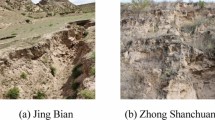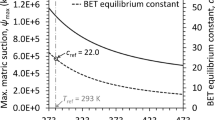Abstract
Purpose
Non-ideal or fractional wettability conditions may exist at field sites. It was hypothesized that fractional wettability could cause larger entrapped LNAPL saturations and unexpected soil interactions during surfactant remediation. Soil wettability effects during entrapped LNAPL recovery by surfactant flooding in coarse-grained sand were investigated through a comparative study. The main objective was to identify the impacts of soil wettability on LNAPL removal via submicellar concentration surfactant flooding to remobilize entrapped LNAPL.
Materials and methods
A baseline for comparison was established by testing an ideal water-wet soil (silica sand) along with a fractionally wet soil. Two LNAPLs were tested: LNAPL from a contaminated field site and heptane, which represented an ideal lab-grade fluid. Contact angle, interfacial tension, capillary pressure–saturation, and column tests were performed to characterize wettability and identify the effects of soil wettability during entrapped LNAPL recovery. Two anionic surfactants were used for the column experiments: sodium dodecyl-benzene-sulfonate and a field site anionic surfactant. To further investigate the effects of LNAPL contact time within the soil, columns tests were performed at two different LNAPL contact times.
Results and discussion
Contact angle measurements and column tests conducted with the field LNAPL revealed its potential to establish non water-wet wettability conditions. Column test results indicated that fluid entrapment was independent of fluid type, and the wettability and contact time conditions studied. Entrapped LNAPL saturations after water flooding were approximately 19 %. Entrapped LNAPL removal by mobilization occurred at the predetermined submicellar surfactant concentration (0.5 g/L) with a maximum removal of 43 %. Entrapped LNAPL removal from fractionally wet columns was higher in comparison to water-wet columns and was found to increase with contact time.
Conclusions
Entrapped LNAPL saturations after water imbibition were not impacted by the wettability conditions studied. The fractionally wet soil behaved differently during the surfactant-flood; higher LNAPL removal was achieved suggesting that non-ideal wettability had a positive impact. The presence of NAPL-wet mineral grains might have favored pore scale interactions causing NAPL redistribution and increasing NAPL-surfactant solution interfacial areas contributing to LNAPL removal. Pore scale studies and subsequent testing is recommended to further this study’s findings.




Similar content being viewed by others
References
Abriola LM, Bradford SA (1998) Experimental investigations of the entrapment and persistence of organic liquid contaminants in the subsurface environment. Environ Health Perspect 106(4):1083–1095
Aggelopoulos CA, Tsakiroglou CD (2008) The effect of micro-heterogeneity and capillary number on capillary pressure and relative permeability curves of soils. Geoderma 148(1):25–34
Ahmed ME, Van Geel PJ (2009) Potential concerns related to using octadecyltrichlorosilane (OTS) in rendering soils and porous ceramics hydrophobic. J Contam Hydrol 110(1–2):22–33
Allred B, Brown GO (1996) Boundary condition and soil attribute impacts on anionic surfactant mobility in unsaturated soil. Ground Water 34(6):964–971
Al-Raoush R (2009) Impact of wettability on pore-scale characteristics of residual nonaqueous phase liquids. Environ Sci Technol 43(13):4796–4801
Anderson WG (1986) Wettability literature survey—part 2: wettability measurement. J Petrol Technol 38(12):1246–1262
Anderson WG (1987a) Wettability literature survey—part 4: effects of wettability on capillary pressure. J Petrol Technol 39(10):1283–1300
Anderson WG (1987b) Wettability literature survey—part 5: the effects of wettability on relative permeability. J Petrol Technol 39(11):1453–1468
Bauters TJW, DiCarlo DA, Steenhuis TS, Parlange JY (2000) Soil water content dependent wetting front characteristics in sands. J Hydrol 231–232:244–254
Bettahar M, Ducreux J, Schaefer G, van Dorpe F (1999) Surfactant enhanced in situ remediation of LNAPL contaminated aquifers; large scale studies on a controlled experimental site. Transp Porous Media 37(3):255–276
Bradford SA, Leij FJ (1995) Fractional wettability effects on two-and three-fluid capillary pressure–saturation relations. J Contam Hydrol 20(1–2):89–109
Bradford SA, Leij FJ (1996) Predicting two- and three-fluid capillary pressure–saturation relationships of porous media with fractional wettability. Water Resour Res 32(2):251–259
Bradford SA, Abriol LM, Leij FJ (1997) Wettability effects on two- and three-fluid relative permeabilities. J Contam Hydrol 28(1–2):171–191
Chevalier LR (2003) Surfactant dissolution and mobilization of LNAPL contaminants in aquifers. Environ Monit Assess 84(1–2):19–33
Chevalier LR, Morris T, Allen C, Lazarowtiz V, Fektenberg L (2000) Comparison of primary and secondary flushing to enhance LNAPL recovery. J Soil Contam 9(5):425–448
Combes R, Robin M, Blavier G, Aidan M, Degreve F (1998) Visualization of imbibition in porous media by environmental scanning electron microscopy: application to reservoir rocks. J Petrol Sci Eng 20(3–4):133–139
Drake SS (2011) Wettability characterization for diesel fuels of two different origins. M.Eng.Sc. thesis, University of Western Ontario
Dubey ST, Waxman MH (1989) Asphaltene adsorption and desorption from mineral surfaces. Proceedings: 1989 SPE International Symposium on Oilfield Chemistry, Febrary 8, 1989 - Febrary 10, Publ by Soc of Petroleum Engineers of AIME 51-62:18462
Dubey ST, Waxman MH (1991) Asphaltene adsorption and desorption from mineral surfaces. SPE Reserv Eng 6(3):389–395
Dwarakanath V, Kostarelos K, Pope GA, Shotts D, Wade WH (1999) Anionic surfactant remediation of soil columns contaminated by nonaqueous phase liquids. J Contam Hydrol 38(4):465–488
Dwarakanath V, Jackson RE, Pope GA (2002) Influence of wettability on the recovery of NAPLs from alluvium. Environ Sci Technol 36(2):227–231
Flaming JE, Knox RC, Sabatini DA, Kibbey TC (2003) Surfactant effects on residual water and oil saturations in porous media. Vadose Zone J 2:168–176
Goudar C, Strevett K, Grego J (1999) Competitive substrate biodegradation during surfactant-enhanced remediation. J Environ Eng 125(12):1142–1148
Gvirtzman H, Roberts PV (1991) Pore scale spatial analysis of two immiscible fluids in porous media. Water Resour Res 27(6):1165–76
Hugaboom DA, Powers SE (2002) Recovery of coal tar and creosote from porous media; the influence of wettability. Ground Water Monit R 22(4):83–90
Jahan K, Balzer S, Mosto P (2008) Toxicity of nonionic surfactants. Environ Toxicol II WIT Trans Ecol Environ 110:281–290
Lord DL, Demond AH, Salehzadeh A, Hayes KF (1997a) Influence of organic acid solution chemistry on subsurface transport properties; 2, capillary pressure–saturation. Environ Sci Technol ES T 31(7):2052–2058
Lord DL, Demond AH, Salehzadeh A, Hayes KF (1997b) Influence of organic acid solution chemistry on subsurface transport properties; 1, surface and interfacial tension. Environ Sci Technol ES T 31(7):2045–2051
Lord DL, Demond AH, Salehzadeh A, Hayes KF (2000) Effects of organic base chemistry on interfacial tension, wettability, and capillary pressure in multiphase subsurface waste systems. Transp Porous Media 38(1–2):79–92
Maddin CM (1991) Marine toxicity and persistence of surfactants used in the petroleum producing industry. Proceedings of the First International Conference on Health, Safety and Environment in Oil and Gas Exploration and Production. Part 2 (of 2):339-348
Martel R, Gelinas PJ, Saumure L (1998) Aquifer washing by micellar solutions: 3 field test at the Thouin Sand Pit (L'Assomption, Quebec, Canada). J Contam Hydrol 30(1–2):33–48
Masalmeh SK (2002) Studying the effect of wettability heterogeneity on the capillary pressure curves using the centrifuge technique. J Petrol Sci Eng 33(1–3):29–38
Molnar IL, O'Carroll DM, Gerhard JI (2011) Impact of surfactant-induced wettability alterations on DNAPL invasion in quartz and iron oxide-coated sand systems. J Contam Hydrol 119(1–4):1–12
O'Carroll DM, Bradford SA, Abriola LM (2004) Infiltration of PCE in a system containing spatial wettability variations. J Contam Hydrol 73(1–4):39–63
O'Carroll DM, Abriola LM, Polityka CA, Bradford SA, Demond AH (2005) Prediction of two-phase capillary pressure–saturation relationships in fractional wettability systems. J Contam Hydrol 77(4):247–270
Powers SE, Tamblin ME (1995) Wettability of porous media after exposure to synthetic gasolines. J Contam Hydrol 19(2):105–125
Powers SE, Anckner WH, Seacord TF (1996) Wettability of NAPL-contaminated sands. J Environ Eng 122(10):889–896
Renshaw CE, Zynda GD, Fountain JC (1997) Permeability reductions induced by sorption of surfactant. Water Resour Res 33(3):371–378
Rosen MJ (1989) Surfactants and interfacial phenomena. Wiley, New York
Rouse JD, Sabatini DA, Harwell JH (1993) Minimizing surfactant losses using twin-head anionic surfactants in subsurface remediation. Environ Sci Technol 27(10):2072–2078
Ryder JL, Demond AH (2008) Wettability hysteresis and its implications for DNAPL source zone distribution. J Contam Hydrol 102(1–2):39–48
Said M (2010) Characterization of soil wettability changes of a diesel-impacted field soil. M.A.Sc. thesis, Carleton University
Salehzadeh A, Demond AH (1999) Pressure cell for measuring capillary pressure relationships of contaminated sands. J Environ Eng 125(4):385–388
Sigma-Aldrich (2010) Sodium dodecylbenzenesulfonate MSDS No. 289957. http://www.sigmaaldrich.com/MSDS/MSDS/DisplayMSDSPage.do?country=CA&language=en&productNumber=289957&brand=ALDRICH&PageToGoToURL=http%3A%2F%2Fwww.sigmaaldrich.com%2Fcatalog%2Fproduct%2Faldrich%2F289957%3Flang%3Den. Accessed 16 August 2011
Somasundaran P, Zhang L (2006) Adsorption of surfactants on minerals for wettability control in improved oil recovery processes. J Petrol Sci Eng 52(1–4):198–212
Spangle MG, Handy RL (1982) Soil engineering. Harper and Row, New York
Tsai TT, Kao CM, Surampalli RY, Liang SH (2009) Treatment of fuel-oil contaminated soils by biodegradable surfactant washing followed by Fenton-like oxidation. J Environ Eng 135(10):1015–1024
Van Genuchten MT (1980) A closed-form equation for predicting the hydraulic conductivity of unsaturated soils. Soil Sci Soc Am J 44(5):892–898
Zheng J, Powers SE (1999) Organic bases in NAPLs and their impact on wettability. J Contam Hydrol 39(1–2):161–181
Zheng JZ, Behrens SH, Borkovec M, Powers SE (2001) Predicting the wettability of quartz surfaces exposed to dense nonaqueous phase liquids. Environ Sci Technol 35(11):2207–2213
Acknowledgments
The authors would like to thank their colleagues and staff at Carleton University, especially, Michelle Roberge, Mostafa Said, Dr. Marie Tudoret Chow, Stanley Conley, Pierre Trudel, and Jason Arnott. They also thank Dr. Dennis O’Carroll and Stephanie Drake at the University of Western Ontario for their help and assistance in the contact angle and IFT measurements. Likewise, they express their gratitude to the Colombian Petroleum Institute, especially to Engineers Mauricio Cardeñosa Mendoza and Adriana Serrano Santiago for providing and assisting in the sampling, handling and shipping of the field site samples.
Author information
Authors and Affiliations
Corresponding author
Additional information
Responsible editor: Ying Ouyang
Rights and permissions
About this article
Cite this article
Puentes Jácome, L.A., Van Geel, P.J. An initial study on soil wettability effects during entrapped LNAPL removal by surfactant flooding in coarse-grained sand media. J Soils Sediments 13, 1001–1011 (2013). https://doi.org/10.1007/s11368-013-0673-7
Received:
Accepted:
Published:
Issue Date:
DOI: https://doi.org/10.1007/s11368-013-0673-7




